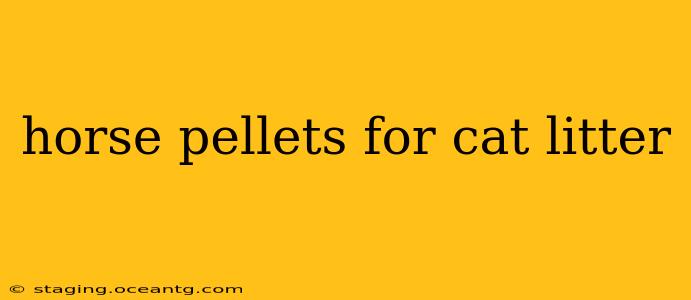Horse pellets, often used as bedding for horses, have surprisingly emerged as a potential alternative to traditional cat litter. While this unconventional choice sparks debate, understanding its pros and cons is crucial for any cat owner considering this option. This comprehensive guide will explore the viability of using horse pellets for cat litter, addressing common concerns and providing a balanced perspective.
Why Would Someone Use Horse Pellets for Cat Litter?
The primary driver behind using horse pellets is their cost-effectiveness. Compared to commercial cat litters, horse pellets are significantly cheaper, especially for owners with multiple cats or those who frequently replenish their litter boxes. This economic advantage is particularly attractive in times of rising living costs.
What are the Advantages of Using Horse Pellets as Cat Litter?
- Cost Savings: As mentioned, the most significant advantage is the lower price point compared to traditional options.
- Absorbency: Many horse pellet types are highly absorbent, capable of effectively soaking up urine and minimizing odors. However, the level of absorbency varies depending on the pellet composition and density.
- Dust Reduction (Potentially): Some users report less dust compared to certain clay-based litters, beneficial for cats and owners with respiratory sensitivities. However, this isn't universally true; the dust level depends greatly on the type of pellet.
- Environmentally Friendly (Potentially): Depending on the source and processing of the pellets, this option could be considered more eco-friendly than some commercially produced litters. However, this is highly dependent on the specific product and its sustainability practices.
What are the Disadvantages of Using Horse Pellets as Cat Litter?
- Dust: While some experience less dust, others report significant dust generation, especially during the scooping process. This can irritate both cats and humans.
- Odor Control: While absorbency is often good, odor control can be inconsistent. Unless the pellets are changed frequently, unpleasant smells can still linger.
- Tracking: Unlike clumping litters, horse pellets tend to stick to paws more easily, leading to increased tracking throughout the house.
- Clumping Issues: Horse pellets do not clump like traditional clumping litters. This makes scooping more challenging and less efficient, often requiring complete litter box changes more frequently.
- Potential for Ingestion: Cats might accidentally ingest pellets, potentially causing digestive issues. While generally non-toxic, this is still a risk to consider.
- Not Suitable for All Cats: Some cats are simply not receptive to this type of litter and may refuse to use the box if it contains horse pellets.
Are Horse Pellets Safe for Cats?
While generally non-toxic, the safety of horse pellets as cat litter depends on several factors:
- Ingredients: Ensure the pellets are made from natural materials and free from harmful chemicals or additives.
- Ingestion: Monitor your cat for any signs of pellet ingestion, such as digestive upset or changes in bowel movements.
- Individual Sensitivities: Some cats may be more sensitive than others, developing skin irritation or allergic reactions.
How Do Horse Pellets Compare to Other Litters?
Compared to clay-based litters, horse pellets offer potential cost savings but may lack the clumping and odor control features. They are also less convenient than silica gel litters, which offer excellent odor control, but are more expensive.
Are all horse pellets suitable for use as cat litter?
No, not all horse pellets are created equal. Some are heavily treated or contain additives that might be harmful to cats. Always choose untreated, natural horse pellets specifically intended for bedding use. Check the ingredient list carefully before using any product.
How often should I change horse pellet litter?
Because horse pellets don't clump, you'll need to replace the litter more frequently than with clumping litter. Aim for a complete change every few days, or whenever you notice a significant build-up of waste.
What should I do if my cat shows signs of illness after using horse pellets?
Consult your veterinarian immediately if your cat exhibits any signs of illness after using horse pellets as litter.
In conclusion, while horse pellets offer a potentially budget-friendly option for cat litter, careful consideration of the pros and cons is vital. Their suitability depends heavily on the individual cat and their preferences, alongside diligent monitoring for any potential health issues. Always prioritize your cat's well-being and comfort when choosing a litter type. The cost savings might not outweigh potential issues for some cats and owners.
